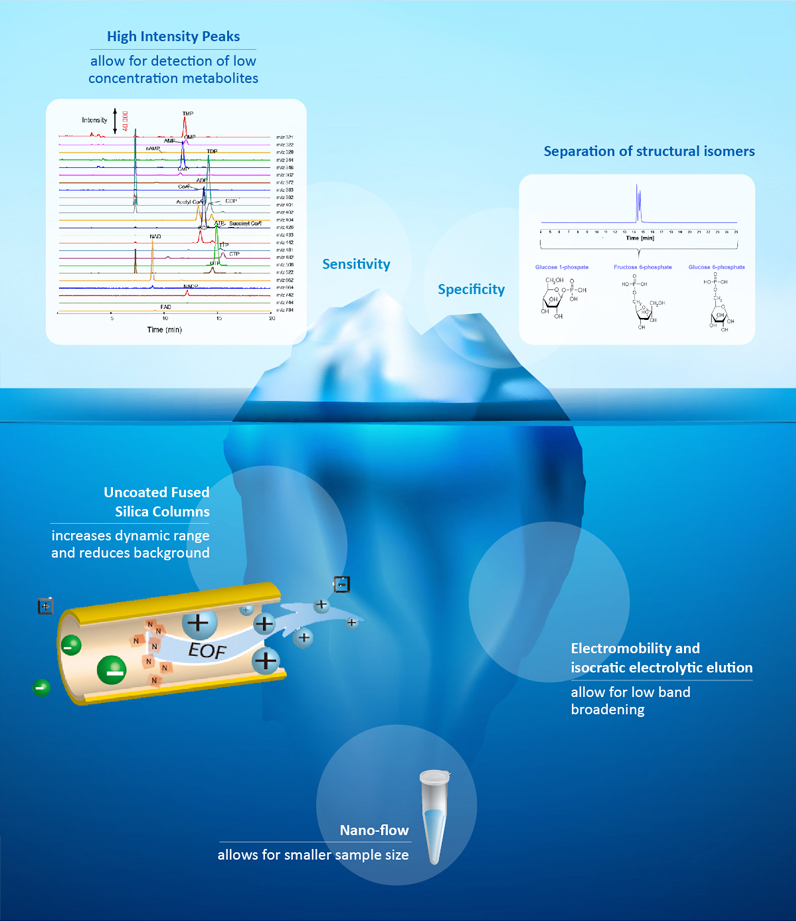Advantages of CE over LC and GC as a separation technique for polar metabolites include:
- Superior separation performance for many polar, semi-volatile, hydrophilic and charged metabolites
- Less susceptibility to matrix effects and wider dynamic range due to isocratic elution and use of uncoated fused-silica columns
- Resolution of isobaric metabolites – separation of structural and positional isomers
- Unique chemical space allows for the discovery of novel polar metabolites
- Better performance control due to a relatively simpler separation principle based an isocratic elution separation based on charge and size in an electrical field vs traditional stationary phase gradient elution methods using HPLC.
Capillary electrophoresis mass spectrometry (CE-MS), is a very powerful measurement method in cases requiring high quantitative and qualitative performance for polar metabolites, capable of expanding major metabolic pathway maps and discovering novel biomarkers.
High Resolution
The high-resolution ability of CE enhances the separation of compounds, key to the identification and annotation of metabolites from a metabolome pool comprising of thousands of chemical compounds with many isomers. There are a lot of metabolites with similar chemical structure and physical properties, with significantly different biological functions in biological systems. For example, the CE separation and identification of Pyruvate and Lactate, important intermediates and end-product of glycolysis, is essential for pathway understanding. CE can separate many other isomeric compounds, for example, Glucose-6-phosphate, Glucose-1-Phosphate and Fructose-6-phosphate, which all have the same chemical formula and molecular weights, are not resolved by LC-MS, but can be separated and quantitated by CE-MS. The employment of CE-MS in metabolomics provides higher resolution profiling of many metabolic intermediates including branched vs unbranched metabolites. Differences in fatty acid oxidation, biosynthesis, recycling, and changes in the microbiome are often represented by differences in these isomer abundances.
High Sensitivity and Linearity
Together with high separation ability, the low sample volume in CE-MS enables accurate quantitation for a variety of metabolites. The low injection volume required for each sample effectively reduces the matrix effect, which is caused by a variety of ionic compounds including salt, protein, and RNA derived from biological samples. The reduction of the matrix effect is important for not only the separation of peaks in CE, but also quantitation capabilities. Within each sample, the composition of the salt, solvent, or too high of a metabolite concentration can cause ion suppression resulting in insufficient ionization of target compounds. Ion suppression will lower the intensity of detection peaks and decrease the performance of quantitation especially for high- and low- concentration metabolites in the sample.
Because metabolites exist with a large range of concentrations, a wide range of quantitation linearity is required for precise measurement for biomarker screening, relative comparisons, and quantitative measurements. CE-MS requires an ~50 nano-L injection of the sample solution and therefore has a lower ion suppression and higher peak intensity compared with conventional methods such as LC-MS and GC-MS.

How it works
Capillary electrophoresis is called free zone electrophoresis because it uses uncoated hollow fused silica capillary tubes filled with only an electrolyte solution. An electric field is generated by applying a voltage of over 30KV to both ends of the capillary, the direction and rate of migration of metabolite ions depend on the physical properties of each metabolite.
Concurrent separation of hundreds to thousands of metabolites is achieved through differences in the mobility of ions through the electric field. The rate of migration of ions in an electric field is dependent upon size, charge, and shape of each metabolite. This method of separation is referred to as EOF, electroosmotic flow. The principles of EOF not only provide the basis of high resolution, separation of isomers and optimization for polar metabolites, but also provides the basis for our ability to predict structure based upon elemental formula and migration time. The unique features of CE allow for metabolite migration time prediction and the basis for our OMEGA Search and advanced modes that an add new level 2 annotations to our annotated reports. This additional capability separates CE even more from the traditional HPLC separation methods.
Unique Chemical Space
Because CE is suitable for the separation of ionic and hydrophilic compounds, CE-MS based metabolomics has advantages in the measurement of compounds including organic acids, amino acids, phosphorylated sugars, small peptides, nucleotides, etc. Clinical samples such as blood, urine, and CSF include many hydrophilic compounds secreted from cells, whose profiling is essential for biomarker discovery, analysis of disease progression or treatment effects.
The discovery of novel metabolites is now possible when probing the metabolome with this novel technology. The specific attributes that best suit CE allow for discovery of new metabolites not observed by the hydrophobic preference of LC. Such new metabolites may represent new pathways, new paths for recycling metabolites, nutrient processing, microbiome changes or more.
Additional Readings:
The use of a double coaxial electrospray ionization sprayer improves the peak resolutions of anionic metabolites in capillary ion chromatography-mass spectrometry
Recent advances in capillary electrophoresis‐mass spectrometry: Instrumentation, methodology and applications
CE‐MS for metabolomics: Developments and applications in the period 2016–2018
Comprehensive Profiling by Non‐targeted Stable Isotope Tracing Capillary Electrophoresis‐Mass Spectrometry: A New Tool Complementing Metabolomic Analyses of Polar Metabolites
